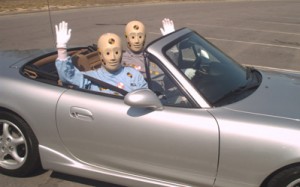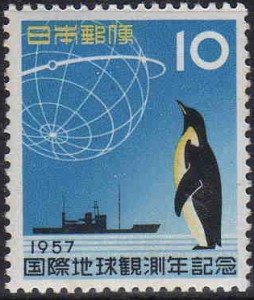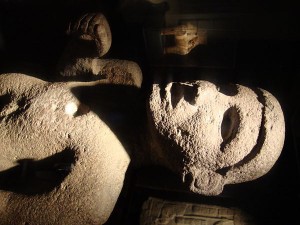A Michael Matas TED Talk about the coming evolution of e-books. The Kindle probably needs to be free and ubiquitous really soon in order to have a future. (Thanks Open Culture.)
You are currently browsing the yearly archive for 2011.
Tags: Micahel Matas
A Radiolab series called Limits examines how far humans can push themselves in a variety of ways. In one episode, entitled “Limits of the Mind,” hosts Jad Abumrad and Robert Krulwich explore the outer boundaries of memory, focusing on the story of 1920s Russian journalist Mr. S., (Solomon Veniaminovich Shereshevsky, to be precise), who had a memory so elastic so as to be almost without borders. Mr. S., who was the subject of a book and became a popular mnemonist who performed at circuses, suffered from a neurological disorder known as Synesthesia, which was responsible for his remarkable recall and many of his problems in life. (Thanks Atlantic.)
Tags: Jad Abumrad, Robert Krulwich, Solomon Veniaminovich Shereshevsky
Doesn’t sass you like those punks at the Key Food. (Thanks IEEE Spectrum.)
A muckraker and an artist, the great photographer Lewis Hine took this classic 1917 shot of 12-year-old barber Frank De Natale plying his trade in Boston. By this point, child labor laws, which Hine’s work had helped advance, precluded this lad from working full-time; he was a barber after-school and on Saturdays. A note from an 1884 Brooklyn Daily Eagle article about the child barbers of an earlier era:
“‘How are barbers taught?’
‘We generally get small boys. They are regularly indentured to us by their parents. They are compelled to stay with us for three years. We give them about $50 for the first year and increase their wages as they become accustomed to the work. At first they do nothing but brush the clothes of the customers. Then we make them watch us while we are shaving or hair cutting. If the boy is smart he is soon permitted to lather the customers’ faces, while the hands are busy with other men. They finally graduate into full fledged barbers and receive a salary of from $5 to $12 per week.'”
Tags: Frank De Natale, Lewis Hine
You are making me angry (u know where)
As far as the Baymont Inn and Suites in Pensacola Florida, I better not hear of one more person posting a bad review for Mr Patel’s property. Not on Yahoo, not on trip advisor, not no where. I am going to start walking mud puddles in peoples butt. I will know who you are. If you are smart you will shut your pie hole.
The heft of Google’s wealth and influence is squarely behind the proliferation of self-driving cars, a concept which has been around since the 1950s and may be coming to Nevada roads in the near future. John Markoff reports in the New York Times:
“Google, a pioneer of self-driving cars, is quietly lobbying for legislation that would make Nevada the first state where they could be legally operated on public roads.
And yes, the proposed legislation would include an exemption from the ban on distracted driving to allow occupants to send text messages while sitting behind the wheel.
The two bills, which have received little attention outside Nevada’s Capitol, are being introduced less than a year after the giant search engine company acknowledged that it was developing cars that could be safely driven without human intervention.
Last year, in response to a reporter’s query about its then-secret research and development program, Google said it had test-driven robotic hybrid vehicles more than 140,000 miles on California roads — including Highway 1 between Los Angeles and San Francisco.
More than 1,000 miles had been driven entirely autonomously at that point; one of the company’s engineers was testing some of the car’s autonomous features on his 50-mile commute from Berkeley to Google’s headquarters in Mountain View.”
Tags: John Markoff
Typing words instead of processing them. (Thanks Reddit.)
The opening of “Cities of New York,” from Pete Hamill’s excellent collection, Piecework, in which the writer recalls NYC’s mid-twentieth century decline, which didn’t reverse until new media technology businesses began to take root in the city in the 1990s:
“If I’d grown up in another city, I almost certainly would have become another kind of writer. Or I might not have become a writer at all. But I grew up in New York in the 1940s, when New York was a great big optimistic town. The war was over and the Great Depression was a permanent part of the past; now we would all begin to live. To a kid (and to millions of adults) everything seemed possible. If you wanted to be a scientist or a left-fielder for the Dodgers, a lawyer or a drummer with Count Basie: well, why not? This was New York. You could even be an artist. Or a writer.
As a man and a writer, I’ve been cursed by the memory of that New York. Across five decades, I saw the city change and its optimism wane. The factories began closing in the late 1950s, moving to the South, or driven out of business by changing styles or tastes or means of production. When the factories died, so did more than a million manufacturing jobs. Those vanished jobs had allowed thousands of men like my father (an Irish immigrant with an eighth-grade education) to raise families in the richest city on earth. They joined unions. They proudly voted for the Democratic ticket. The put paychecks on kitchen tables, asked their kids if they’d finished their homework, went off to night games at the Polo Grounds or Ebbets Field, and were able to walk in the world with pride. Then the great change happened. The manufacturing jobs were replaced with service work. Or with welfare. One statistic tells the story: In 1955, there were 150,000 New Yorkers on welfare; in 1995, there were 1.3 million.
With the jobs gone, the combined American plagues of drugs and guns came to the neighborhoods.”
••••••••••
Pete Hamill discusses the legacy of Frank Sinatra on local NYC news:
Tags: Frank Sinatra, Pete Hamill
Meghalaya, India, is a very wet place, so the locals use roots from live strangler figs to build pedestrian bridges that are alive. Video from BBC’s Human Planet series.
The opening of Jesse McKinley’s well-written New York Times account of the strange murder of Riverside, California, resident Jeff Hall, a representative of the neo-Nazi National Socialist Party, who was recently shot to death by his tow-headed ten-year-old son:
“The day before he allegedly shot his father, the sandy-haired 10-year-old boy showed off a prized possession to a visitor. It was a thin leather belt emblazoned with a silver insignia of the Nazi SS.
‘Look what my dad got me,’ the boy said shyly, perched on the living room stairs, one of the few quiet spots in a house with five children.
A little more than 12 hours later, the police say, the boy stood near those stairs with a handgun and killed his father, Jeff Hall, as he lay on the living room couch. It was about 4 a.m. on May 1; paramedics declared Mr. Hall dead when they arrived.
The police say that the killing was intentional, but that the motives behind it are still not fully understood. But whatever the reason, it has cast fresh light on the fringe group to which Mr. Hall devoted his life: the National Socialist Movement, the nation’s largest neo-Nazi party, whose message stands in surreal juxtaposition to the suburban, workaday trappings of many of its members.”
••••••••••
Hall can be seen at this creepy 2009 anti-immigration rally. He’s the speaker with the shaved head who’s on camera early in the clip:
Tags: Jeff Hall, Jeffe McKinley
A quick jolt of Martha Graham on what would have been her 117th birthday.
By the way, the artist who created the amazing Google logo animation celebrating Graham is Ryan Woodward. This animated dance is also his:
Tags: Martha Graham, Ryan Woodward
In 1957-58, 64 nations from both sides of a Cold War that would continue for three more decades came together to perform large-scale scientific research as part of an alliance known as International Geophysical Year. It was an unprecedented display of global information sharing, with satellites launched and knowledge of space travel gained. Life magazine covered the outset of the project with the article, “The World Studies the World.” An excerpt:
“Through the top of a strange sheet-metal shack at Ft. Churchill, Manitoba, a powerful research rocket last week streaked into the upper air to perform one of the first major experiments of the newly launched International Geophysical Year. While the rocket is radioing its data from 160 miles up, a team of seismologists deep in a Chilean tunnel were taking data from earthquake recorders. A pair of oceanographers on the remote Pacific island of Jarvis were collecting samples of ocean water. And in the South Pole Americans were observing the fluctuations of a rare red aurora.
In hundreds of other places and ways, 8,000 scientists of 64 nations were starting history’s most ambitious scientific research program. In the IGY, says Dr. Joseph Kaplan, chairman of U.S. IGY committee, ‘scientists of the world are going to take a long and special look at our earth –at its wrinkled crust, its hot heart, its deep seas, its envelope of air, its mighty magnetism, its relationship to outer space.’
IGY, which will last for 18 months through December 1958, will cost half a billion dollars. Its end results should be of extreme practical value; vastly improved communications, more accurate navigation for ships and planes, billions of dollars and many lives saved with improved weather forecasting, and further progress toward mastery of polar regions and outer space.”
••••••••••
Donald Fagen sings a hopeful 1982 song which he wrote from the vantage point of those involved in IGY: “Here at home we’ll play in the city / Powered by the sun / Perfect weather for a streamlined world / There’ll be spandex jackets, one for everyone.”
Tags: Donald fagen, Dr. Joseph Kapla
You remember Ayn Rand. She was that novelist who believed a woman should not be President. Mike Wallace interviews her in 1959. (Thanks Open Culture.)
Tags: Ayn Rand, Mike Wallace

"Does anybody believe that a race of gigantic men, who were 12 to 30 feet high, ever lived in these United States of America?"
While the following article from the May 16, 1900 Brooklyn Daily Eagle, which was repinted from the Prescott Prospect, doesn’t prove that a race of 20-foot giants once roamed America, it is conclusive evidence that the newspaper’s editors had been drinking heavily. An excerpt:
“Does anybody believe that there ever has been a race of giants in the world? Does anybody believe that a race of gigantic men, who were 12 to 20 feet high, ever lived in these United States of America? And yet the proof that such a race of people did live in this country is to be found in the Grand Canyon of the Colorado River in northern Arizona. This proof consists of, first, footprints in the red sandstone, footprints that appear to have been made by the moccasined feet of gigantic men, men whose tracks measured twenty inches in length and who stepped five feet at a stride.
The second proof is that there is the petrified body of such a man likewise in the red sandstone of the Grand Canyon district. This body was of a living, breathing man, but after death the flesh was replaced by lime or silica, held in solution in the water. There is ample evidence that nature was able to perform this feat, as the petrifying process is being carried on in the canyon to this day. The third fact is that there is and was a strong and almost universal tradition among the ancient people of Mexico and Peru that such a race of giants lived in their country.
Perhaps it is almost too much to call this proof, but it is at least corroborative testimony. Last June I visited the Grand Canyon as a tourist. There I met Mr. Hull, who was acting as a guide into the canyon and who was a pioneer of northern Arizona. He told me the following story, and with apologies for my credulity, I believe him.
Three years ago he and a companion named Jim Lavelle had been prospecting in this part of the country. They found a ledge which they thought was valuable and had started out of the canyon with samples of the ore, expecting to return in a few days. One of the Indians was with them. Mr. Hull speaks the Indian language fluently, and the Indians have a great admiration for him. The Indian said, ‘Have you ever seen the big Indian up here?’ volunteering to show it. They followed him up a foot trail, which led through a crevice in the red wall, thence on to the bench like formation above but still in the midst of the red sandstone.
They came to a place where a projecting rock formed a shelter over a sloping table like slab of stone which was covered with a white incrustation of lime. Outstretched on this slab was the body of a gigantic man turned into stone. The body was entirely nude and lay face downward. They estimated his height at 18 or 20 feet. They looked at it 10 or 20 minutes and then continued their journey, intending to return and make a more complete investiagtion. Plans changed and they failed to return.
This was startling information, but I had been in a measure prepared for it. It had always seemed reasonable to me that the prehistoric, primeval hunting savages should have been of large stature.”
Tags: Jim Lavelle, Mr. Hull
And then it celebrates. (Thanks Singularity Hub.)
••••••••••
Hungarian architect Ernő Rubik discusses his famous puzzle in 1981:
“Of course you can’t give the exact time of an idea’s birth, it seems impossible to me, to me particularly, for who time, from this point of view, has very little interest. It can have been in spring, 1974 that the idea came to me, as a noteworthy possibility. I have a nature attached to experiences, so, since the beginning, I studied variations of a 2x2x2 cube. I was immediately struck by the wealth that could be sensed only from this start. The final technical solution, which is the simplest form 3x3x3, the most easily workable in models, after a few tries, came to me toward the end of autumn, 1974. Several models ready to work were made for me and my friends, it has been exciting to play with them for the first time. We were all surprised to discover gradually that we had made something original, new.The question of the patent of the invention was immediately raised, so I began the necessary process the 30 January, 1975. Almost at the same, sensing something of the importance of the invented game, of its possibilities and of its real value, I began searching for a partner for the manufacturing and by an extraordinary chance, I indeed found one. The following is rather simple : after its launch on the market (1977) the game became, rapidly and as if by magic, very popular in Hungary, then, from 1980 in the whole world. I feel like the story only begins, and that we can’t predict the end, as well as nobody, I think, could have guessed its future.”
Tags: Ernő Rubik
Hanna Rosin’s 2010 Atlantic article, “The End Of Men,” concerns American males falling further and further behind women in education, employment, etc. The opening focuses on biologist Ronald Ericsson, who caused a media-stoked panic in the 1970s when he created a method that purportedly allows parents to choose the sex of their offspring. This development led some feminists to fear that women would be doomed in America. An excerpt:
“IN THE 1970s the biologist Ronald Ericsson came up with a way to separate sperm carrying the male-producing Y chromosome from those carrying the X. He sent the two kinds of sperm swimming down a glass tube through ever-thicker albumin barriers. The sperm with the X chromosome had a larger head and a longer tail, and so, he figured, they would get bogged down in the viscous liquid. The sperm with the Y chromosome were leaner and faster and could swim down to the bottom of the tube more efficiently. Ericsson had grown up on a ranch in South Dakota, where he’d developed an Old West, cowboy swagger. The process, he said, was like ‘cutting out cattle at the gate.’ The cattle left flailing behind the gate were of course the X’s, which seemed to please him. He would sometimes demonstrate the process using cartilage from a bull’s penis as a pointer.
In the late 1970s, Ericsson leased the method to clinics around the U.S., calling it the first scientifically proven method for choosing the sex of a child. Instead of a lab coat, he wore cowboy boots and a cowboy hat, and doled out his version of cowboy poetry. (People magazine once suggested a TV miniseries based on his life called Cowboy in the Lab.) The right prescription for life, he would say, was “breakfast at five-thirty, on the saddle by six, no room for Mr. Limp Wrist.’ In 1979, he loaned out his ranch as the backdrop for the iconic ‘Marlboro Country’ ads because he believed in the campaign’s central image—’a guy riding on his horse along the river, no bureaucrats, no lawyers,’ he recalled when I spoke to him this spring. ‘He’s the boss.’ (The photographers took some 6,500 pictures, a pictorial record of the frontier that Ericsson still takes great pride in.)
Feminists of the era did not take kindly to Ericsson and his Marlboro Man veneer. To them, the lab cowboy and his sperminator portended a dystopia of mass-produced boys. ‘You have to be concerned about the future of all women,’ Roberta Steinbacher, a nun-turned-social-psychologist, said in a 1984 People profile of Ericsson. ‘There’s no question that there exists a universal preference for sons.’ Steinbacher went on to complain about women becoming locked in as ‘second-class citizens’ while men continued to dominate positions of control and influence. ‘I think women have to ask themselves, ‘Where does this stop?’ she said. ‘A lot of us wouldn’t be here right now if these practices had been in effect years ago.’
Ericsson, now 74, laughed when I read him these quotes from his old antagonist. Seldom has it been so easy to prove a dire prediction wrong.” (Thanks to The Electric Typewriter.)
Fun short 1976 documentary about Lillian Schwartz, an artist who was an early adapter of digital technology and pioneered a merging of computer graphics and fine art.
Tags: Lillian Schwartz
From an 1895 edition of the Brooklyn Daily Eagle:
“Members of the Fifteenth ward citizens’ association for the abolishment of Newtown Creek nuisances are complaining that stenches from the creek at night have increased steadily since April 17, and that the air was so filled with foul smelling vapor at 4 o’clock yesterday morning that sleep was out of the question for people living in the Fifteenth and Eighteenth wards. The members of the citizens’ association insist that fat rendering and bone boiling establishments and fertilizer manufactories on the shores of the creek empty foul smelling material stored during the day into the creek at night, and they believe that if the proprietors of stench emitting factories who are indicted are not speedily brought to trial the nuisances will soon become as intolerable as ever.”
A beautiful passage of the late folkie, Karen Dalton, who was something of a Billie Holiday for the coffee-house set and was sadly plagued by many of the same demons as Lady Day. (Thanks to The Documentarian.)
From the 2007 Guardian article, “The Best Singer You’ve Never Heard Of“: “Dalton turned up in Greenwich Village in the early 60s. She had left behind her husband in Enid, Oklahoma, and arrived with her 12-string guitar, a banjo and at least one of her two children. She began to sing at the pass-the-hat folk venues that were flourishing at the time and played with Bob Dylan, Fred Neil and Richard Tucker. Dylan recalls her as ‘funky, lanky and sultry.’ ‘My favorite singer in the place was Karen Dalton,’ he remembers in Chronicles. ‘Karen had a voice like Billie Holiday’s and played the guitar like Jimmy Reed.'”
Tags: Bob Dylan, Karen Dalton

"If you find any neat dead animals in good condition (raccoons, owls, etc) please put them in a bag and into a freezer immediately and I can taxidermy them!" (Image by Usha Eugene.)
taxidermist needs BIRD CAGES any size or condition (WILLIAMSBURG)
I need bird cages to use as a way to air out carcasses and get the bones from dead animals…I ONLY USE DEAD ANIMALS AND EMPHASIZE THE ETHICS OF TAXIDERMY…NO KILL POLICY….
thanks for any help!
also, if you find any neat dead animals in good condition (raccoons, owls, etc) please put them in a bag and into a freezer immediately and I can taxidermy them!
This classic photo from the Bain Collection profiles members of the women’s police reserve of New York City in 1918, the year that females began participating in the volunteer auxiliary. From a New York Times article about the formation of this new crime-fighting force:.
“New York City’s morals are to be toned up in the near future by the activities of a police reserve of volunteer women. It was announced at Police Headquarters last night that the Police Reserves which Commissioner Enright reorganized out of the Home Defense League, recruited so successfully by his predecessor, Commissioner Woods, was to have the prestige of this auxiliary.
The Special Deputy would not have the women police cope with rough and violent lawbreakers; on the the other hand, their forte under the plan would be to keep a finger on the city’s pulse in an effort to detect signs of unlawful developments before they grew to serious proportions, to watch out for cases of sedition, to uplift the general moral atmosphere of the city in the neighborhood of their posts. If need arose for the use of a nightstick or other instrument for curbing crime, the work would be referred to the men members of the force.”
Tags: Commissioner Enright
 The perfect opening of “The Double Game,” a just-published New Yorker article about the best-laid post-war American plans for Pakistan and India, written by the resolutely excellent Lawrence Wright:
The perfect opening of “The Double Game,” a just-published New Yorker article about the best-laid post-war American plans for Pakistan and India, written by the resolutely excellent Lawrence Wright:
“It’s the end of the Second World War, and the United States is deciding what to do about two immense, poor, densely populated countries in Asia. America chooses one of the countries, becoming its benefactor. Over the decades, it pours billions of dollars into that country’s economy, training and equipping its military and its intelligence services. The stated goal is to create a reliable ally with strong institutions and a modern, vigorous democracy. The other country, meanwhile, is spurned because it forges alliances with America’s enemies.
The country not chosen was India, which ’tilted’” toward the Soviet Union during the Cold War. Pakistan became America’s protégé, firmly supporting its fight to contain Communism. The benefits that Pakistan accrued from this relationship were quickly apparent: in the nineteen-sixties, its economy was an exemplar. India, by contrast, was a byword for basket case. Fifty years then went by. What was the result of this social experiment?
India has become the state that we tried to create in Pakistan. It is a rising economic star, militarily powerful and democratic, and it shares American interests. Pakistan, however, is one of the most anti-American countries in the world, and a covert sponsor of terrorism. Politically and economically, it verges on being a failed state.”
Tags: Lawrence Wright
From “World’s Largest Wooden Structure,” a photo essay on Yatzer.com about Seville’s recently completed Metropol Parasol, which was designed by J. Mayer H. Architects:
“The Metropol Parasol scheme with its imposing timber structure offers a range of attractions and amenities to be used by the public. Such functions include an archaeological museum, a farmers market, an elevated plaza, and multiple bars and restaurants underneath and inside the parasols, as well as a panorama terrace on the upper level of the parasols. Realized as one of the largest and most innovative bonded timber-constructions with a polyurethane coating, the parasols grow out of the archaeological excavation site into a contemporary landmark, thus defining a distinctive relationship between the historical medieval city and the contemporary city beat! Metropol Parasols mix-used multicultural program sets off a dynamic development for culture and commerce in the heart of Seville and beyond.”
Tags: Gil Scott-Heron
















